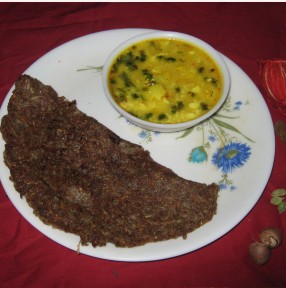 It’s the Basant Navratri again—the nine day spring festival that heralds the onset of the New Year according to the traditional Hindu Vikrami calendar—when devotees observe fasts that culminate in the celebration of Durga Ashtami on the eighth lunar day and Ram Navami (the birth of Lord Rama) on the ninth day.
It’s the Basant Navratri again—the nine day spring festival that heralds the onset of the New Year according to the traditional Hindu Vikrami calendar—when devotees observe fasts that culminate in the celebration of Durga Ashtami on the eighth lunar day and Ram Navami (the birth of Lord Rama) on the ninth day.
“Now, who will fast with me tomorrow?” I remember my grandmother asking us hopefully, the day before the Navratri began, as she cleansed the house of all traces of onions, garlic and eggs (ours being a vegetarian household, there was no question of meat!) and requested Dad to refrain from having over any guests during this period who would have to be served hard drinks. Looking back, I realize she was trying to instil into us some sanskaars (grounding in our own traditions), lest we be completely ‘corrupted’ by ‘western influences’!
Although we looked forward to Navratri (in anticipation of Ashtami, when little girls, as avtars (incarnations) of the Mother Goddess, are pampered in North India with gifts and offerings of the choicest foods), we would all duck out, appalled by the thought of fasting for eight days at a stretch. Grandma would cajole us into fasting on the last day at least, with promises of kuttu pakodas (fritters), aloo chaat, kuttu and potato pooris, and kheer.
Mom would roll her eyes in amusement and demand whether this was the agenda for a vrat (fast) or a charat (a spree of continuous feasting)! And Dad would tell his favourite Navratri anecdote.
“When we were in Engineering College hostel in Kharagpur, one of our friends was warned by his mother about the dates of Navratri and strictly adjured not to touch food with onions in it for that duration. The poor, deluded lady, of course, had no idea that her son used to eat eggs on a regular basis while away from home. And the next thing we knew, the silly fellow asked the canteen cook to prepare his daily omelette without onions!”
The semi-annual Navratri festival (the second one falls in the nine days before Dussehra in October) was probably designated in our traditionally agricultural society as the time for celebrating the harvest, as well as for spiritual and physical spring-cleaning through prayers and fasting during the mild weather preceding the cruel summers and hard winters.
In the course of my Navratri fasts, I have discovered some delicious, low-calorie, quick-to-prepare dishes that take the strain out of fasting—in terms of both hunger as well as time spent in the kitchen! So, here goes:
Potato Kadhi with Kuttu-lauki chillas (serves 4)
(Kuttu is a kind of fruit/nut with a hard shell-like peel that grows in mountainous regions. You crush it to break the shell , sift the chaff and grind the rest to a powder … you get the powder in packages in all the stores in North India during Navratri. A lot of people prefer to substitute singhada flour in the recipes)
Ingredients for the Potato Kadhi:
4 medium-sized potatoes, boiled soft, peeled and coarsely mashed
1 tbsp grated ginger
1 green chilli, finely chopped
2 tbsp fresh dhania (coriander) leaves, finely chopped.
1 tsp zeera (cumin seeds)
½ litre water
2 cups beaten fresh yogurt (dahi)
I tsp ghee
Haldi (turmeric) powder, garam masala, red chilli powder, dhania (coriander) powder and salt to taste
Procedure:
• Melt the ghee in a pan. Splutter the cumin seeds and add the grated ginger, turmeric, red chillies, dhania powder and chopped green chillies. Saute for a few seconds.
• Add the potatoes and mix well for a minute. Add the water and bring to a boil. Add the fresh coriander leaves, a pinch of garam masala and salt (a little more salt than normal, to accommodate the yogurt that is added later).
• Boil for about five minutes on a low flame and take the pan off the fire. Add the beaten yogurt after two minutes, mixing continuously all the time to prevent curdling.
Ingredients for kuttu-lauki chillas (pancakes)
500 grams grated lauki (gourd)
100 grams powdered kuttu
Salt and red chilli powder to taste
Water to make a batter
Ghee for shallow-frying
Procedure
• Mix all the ingredients into a batter of spreading consistency. Spread into round pancakes on a heated tawa (griddle) and shallow-fry with ghee. For low-calorie chillas use a non-stick pan or tawa.






Lovely article Parul, your grannies efforts to instill some “sanskaars” into her grandchildren is a daily struggle for grannies in a modern world
While I have fasted on all 9 days during Navratri, I always wondered why still eat! So, I tried to not eat at all during the day and then slowly over the years, I realized it was about breaking limitations to liberate ourselves just that one bit more.. so, now, I have learned methods that pure and complete–skip a meal and contribute to funds that provide meal to someone who cannot anyway eat, skip buying and contribute to providing meaningful education to someone who cannot study in a school.. my daughter who does not fast but does works to contribute in Empowering and Enhancing.. I believe this is her way of Fasting everyday and praying to the Feminine..www.ishavidhya.org/educate/vrinda
Jai Mata Di!
Sonia
Sounds yummy but wld like to know what kuttu is and where can I find it ?
That’s a truly wonderful gesture, Sonia, and one that we all need to learn from. And this is the true purpose of such festivals … to give us such insights and bring about change in our psyches … thanks for sharing this 🙂